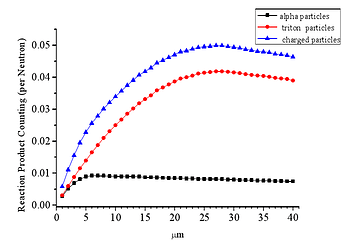Dear FLUKA expert,
In a cylinder(for example, along Z-axis,the beam at Z=0,positive direction,the cylinder is start at Z=0 to Z=2,R=1),how to calculate the energy deposition of a section through the Z-axis(a rectangular section through the axis).
Best,
Xiong.
Dear Xiong,
you can use an USRBIN scoring with an X-Y-Z coordinate system, with 1 bin for each axis.
Alternatively, you can cut your cylinder into two parts with an RPP body, and use an USRBIN scoring with the type: Region.
Cheers,
David
Dear David,
Thank you for your reply,I am a little confused about your help.
What I want to calculate is the axial section like below:

- For the first method,USRBIN with X-Y-Z coordinate system,if I want to calculate the section I should give Coordinate points Z=0 to 2,Y=-1 to 1,X=0 to 0,but X=0 to 0 seems illegal;
- For the second method,RPP is a cuboid,not a cross section,does YZP is better ?
- How should I calculate the relationship between the number of particles and the depth of material like the follow picture?
.

Dear Xiong,
I’m sorry, previously I misunderstood your question, but it is clear now.
-
Scoring energy deposition with USRBIN in an X-Y-Z coordinate system is doable, you only need to specify a thin layer in along the X axis.
-
You can also use an USRBIN scoring with an R-\phi-Z coordinate system, if your problem is symmetric to the axis of the cylinder.
-
The get the particle fluences, you can simply use the USRBIN scorings, but instead of energy you select the particle type you are interested in.
-
It is more difficult to score the particle production (per primary neutron). You need to cut your cylinders into multiple layers and use USRYIELD scorings for each one with the option Yield: EMERGING.
See this topic for more details: Spatial distribution of emerging neutrons
Cheers,
David
Dear David,
1.Just like the first picture,if I want to score the Functional relationship between number of particles and different depth of material in one graph(single particle or not),how should I set the geometry body’s length?Because I find that the geometry body input must be a determined numerical value(can’t be a variable),I guess maybe use something about “#define”,but how to link it with geometry body’s parameter?
2.Like the second picture,only I want to know is the energy deposition of He-4(per He-4 with 2.39Mev input)in a X-Y section and not care the thickness,if I cut it into many layers,how the thickness should I cut,any recommend?
3.How should I simulate a single particle’s reaction? Is it set "START"card’s parameter “No.” to 1?
Dear Xiong,
-
If you want the particle fluence in a fix length target at different depths, then a simple R-\phi-Z USRBIN scoring can be used.
If you want the fluence after a variable length target, you should use an USRBDX scoring , between the target and the downstream region.
It’s correct, that a #define directive can be used to set the length of the target, but for each length a separate simulation will be needed. The easiest way to set this up is to “Loop” the defined variable. See slide 18 of this lecture:
-
For energy deposition by a single particle type you need to use a USRBIN scoring (Particle: ENERGY), plus an AUXSCORE card, where you set the desired particle type.
The thickness is up to you, but the smaller the thickness is, it will require more primaries to get good result in a statistical sense.
-
Scoring only one singe event won’t give appropriate results. However you can use the EVENTBIN scoring which will give you USRBIN like results after each primary. This can be used to postprocess the result.
Cheers,
David
Dear David,
For the second question,As I know USRBDX is used on a given surface,so could I use XYP to cut RRP into two parts and score the interface with USRBDX?
if it yes,other question is how to get the result of single particle interact with it?
cheers,
Xiong
Dear Xiong,
yes, it is correct, to create a surface for USRBDX using an RPP and XYP (or other bodies).
The USRBDX scoring won’t give any meaningful result with only one (or few primaries). If you are interested the properties of single particles crossing a boundary, you may look into the mgdraw.f user routine’s BXDRAW entry.
However, this entry is empty by default. You will have to program it by yourself.
Cheers,
David
Dear David,
I am interested in how many secondary particles will generated at the condition of a single Triton come in.Now I knows,Thank you for your help.
Cheers,
Xiong
